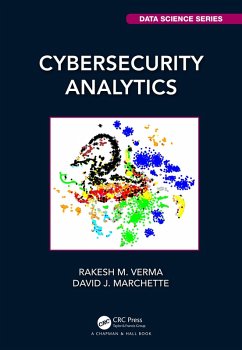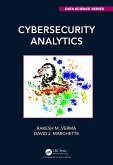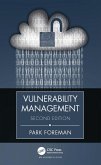

Alle Infos zum eBook verschenken

- Format: PDF
- Merkliste
- Auf die Merkliste
- Bewerten Bewerten
- Teilen
- Produkt teilen
- Produkterinnerung
- Produkterinnerung

Hier können Sie sich einloggen

Bitte loggen Sie sich zunächst in Ihr Kundenkonto ein oder registrieren Sie sich bei bücher.de, um das eBook-Abo tolino select nutzen zu können.
Cybersecurity Analytics is for the cybersecurity student and professional who wants to learn data science techniques critical for tackling cybersecurity challenges, and for the data science student and professional who wants to learn about cybersecurity adaptations. Trying to build a malware detector, a phishing email detector, or just interested in finding patterns in your datasets? This book can let you do it on your own. Numerous examples and datasets links are included so that the reader can "learn by doing." Anyone with a basic college-level calculus course and some probability knowledge…mehr
- Geräte: PC
- mit Kopierschutz
- eBook Hilfe
![Industrial Artificial Intelligence Technologies and Applications (eBook, PDF) Industrial Artificial Intelligence Technologies and Applications (eBook, PDF)]() Industrial Artificial Intelligence Technologies and Applications (eBook, PDF)0,00 €
Industrial Artificial Intelligence Technologies and Applications (eBook, PDF)0,00 €![Cybersecurity Analytics (eBook, ePUB) Cybersecurity Analytics (eBook, ePUB)]() Rakesh M. VermaCybersecurity Analytics (eBook, ePUB)46,95 €
Rakesh M. VermaCybersecurity Analytics (eBook, ePUB)46,95 €![Vulnerability Management (eBook, PDF) Vulnerability Management (eBook, PDF)]() Park ForemanVulnerability Management (eBook, PDF)46,95 €
Park ForemanVulnerability Management (eBook, PDF)46,95 €![Designing Secure Systems (eBook, PDF) Designing Secure Systems (eBook, PDF)]() Michael MeloneDesigning Secure Systems (eBook, PDF)43,95 €
Michael MeloneDesigning Secure Systems (eBook, PDF)43,95 €![Traditional vs Generative AI Pentesting (eBook, PDF) Traditional vs Generative AI Pentesting (eBook, PDF)]() Yassine MalehTraditional vs Generative AI Pentesting (eBook, PDF)43,95 €
Yassine MalehTraditional vs Generative AI Pentesting (eBook, PDF)43,95 €![Secure and Smart Cyber-Physical Systems (eBook, PDF) Secure and Smart Cyber-Physical Systems (eBook, PDF)]() Secure and Smart Cyber-Physical Systems (eBook, PDF)51,95 €
Secure and Smart Cyber-Physical Systems (eBook, PDF)51,95 €![Cybersecurity in the COVID-19 Pandemic (eBook, PDF) Cybersecurity in the COVID-19 Pandemic (eBook, PDF)]() Kenneth OkereaforCybersecurity in the COVID-19 Pandemic (eBook, PDF)19,95 €
Kenneth OkereaforCybersecurity in the COVID-19 Pandemic (eBook, PDF)19,95 €-
-
-
The book includes chapters containing: unsupervised learning, semi-supervised learning, supervised learning, text mining, natural language processing, and more. It also includes background on security, statistics, and linear algebra. The website for the book contains a listing of datasets, updates, and other resources for serious practitioners.
Dieser Download kann aus rechtlichen Gründen nur mit Rechnungsadresse in A, B, BG, CY, CZ, D, DK, EW, E, FIN, F, GR, HR, H, IRL, I, LT, L, LR, M, NL, PL, P, R, S, SLO, SK ausgeliefert werden.
- Produktdetails
- Verlag: Taylor & Francis eBooks
- Seitenzahl: 356
- Erscheinungstermin: 27. November 2019
- Englisch
- ISBN-13: 9781000727654
- Artikelnr.: 58323314
- Verlag: Taylor & Francis eBooks
- Seitenzahl: 356
- Erscheinungstermin: 27. November 2019
- Englisch
- ISBN-13: 9781000727654
- Artikelnr.: 58323314
- Herstellerkennzeichnung Die Herstellerinformationen sind derzeit nicht verfügbar.
David Marchette is a principal scientist at the Naval Surface Warfare Center, Dahlgren Division where he is responsible for leading basic and applied research projects in computational statistics, graph theory, network analysis, pattern recognition, computer intrusion detection, and text analysis. He is a fellow of the American Statistical Association (ASA) and the American Association for the Advancement of Science (AAAS) and an elected member of the International Statistical Institute (ISI).
Data Processing and Cleaning 2.3 Visualization and Exploratory Analysis
2.3.1 Scatterplots 2.4 Pattern Recognition 2.4.1 Classification 2.4.2
Clustering 2.5 Feature extraction 2.5.1 Feature Selection 2.5.2 Random
Projections 2.6 Modeling 2.6.1 Model Specification 2.6.2 Model Selection
and Fitting 2.7 Evaluation 2.8 Strengths and Limitations 2.8.1 The Curse of
Dimensionality 3 Security: Basics and Security Analytics 3.1 Basics of
Security 3.1.1 Know Thy Enemy - Attackers and Their Motivations 3.1.2
Security Goals 3.2 Mechanisms for Ensuring Security Goals 3.2.1
Confidentiality 3.2.2 Integrity 3.2.3 Availability 3.2.4 Authentication
3.2.5 Access Control 3.2.6 Accountability 3.2.7 Non-repudiation 3.3
Threats, Attacks and Impacts 3.3.1 Passwords 3.3.2 Malware 3.3.3 Spam,
Phishing and its Variants 3.3.4 Intrusions 3.3.5 Internet Surfing 3.3.6
System Maintenance and Firewalls 3.3.7 Other Vulnerabilities 3.3.8
Protecting Against Attacks 3.4 Applications of Data Science to Security
Challenges 3.4.1 Cybersecurity Datasets 3.4.2 Data Science Applications
3.4.3 Passwords 3.4.4 Malware 3.4.5 Intrusions 3.4.6 Spam/Phishing 3.4.7
Credit Card Fraud/Financial Fraud 3.4.8 Opinion Spam 3.4.9 Denial of
Service 3.5 Security Analytics and Why Do We Need It4 Statistics 4.1
Probability Density Estimation 4.2 Models 4.2.1 Poisson 4.2.2 Uniform 4.2.3
Normal 4.3 Parameter Estimation 4.3.1 The Bias-Variance Trade-Off 4.4 The
Law of Large Numbers and the Central Limit Theorem 4.5 Confidence Intervals
4.6 Hypothesis Testing 4.7 Bayesian Statistics 4.8 Regression 4.8.1
Logistic Regression 4.9 Regularization 4.10 Principal Components 4.11
Multidimensional Scaling 4.12 Procrustes 4.13 Nonparametric Statistics 4.14
Time Series 5 Data Mining - Unsupervised Learning 5.1 Data Collection 5.2
Types of Data and Operations 5.2.1 Properties of Datasets 5.3 Data
Exploration and Preprocessing 5.3.1 Data Exploration 5.3.2 Data
Preprocessing/Wrangling 5.4 Data Representation 5.5 Association Rule Mining
5.5.1 Variations on the Apriori Algorithm 5.6 Clustering 5.6.1 Partitional
Clustering 5.6.2 Choosing K 5.6.3 Variations on K-means Algorithm 5.6.4
Hierarchical Clustering 5.6.5 Other Clustering Algorithms 5.6.6 Measuring
the Clustering Quality 5.6.7 Clustering Miscellany: Clusterability,
Robustness, Incremental, 5.7 Manifold Discovery 5.7.1 Spectral Embedding
5.8 Anomaly Detection 5.8.1 Statistical Methods 5.8.2 Distance-based
Outlier Detection 5.8.3 kNN based approach 5.8.4 Density-based Outlier
Detection 5.8.5 Clustering-based Outlier Detection 5.8.6 One-class learning
based Outliers 5.9 Security Applications and Adaptations 5.9.1 Data Mining
for Intrusion Detection 5.9.2 Malware Detection 5.9.3 Stepping-stone
Detection 5.9.4 Malware Clustering 5.9.5 Directed Anomaly Scoring for Spear
Phishing Detection 5.10 Concluding Remarks and Further Reading 6 Machine
Learning - Supervised Learning 6.1 Fundamentals of Supervised Learning 6.2
The Bayes Classifier 6.2.1 Naïve Bayes6.3 Nearest Neighbors Classifiers 6.4
Linear Classifiers 6.5 Decision Trees and Random Forests 6.5.1 Random
Forest 6.6 Support Vector Machines 6.7 Semi-Supervised Classification 6.8
Neural Networks and Deep Learning 6.8.1 Perceptron 6.8.2 Neural Networks
6.8.3 Deep Networks 6.9 Topological Data Analysis 6.10 Ensemble Learning
6.10.1 Majority 6.10.2 Adaboost 6.11 One-class Learning 6.12 Online
Learning 6.13 Adversarial Machine Learning 6.13.1 Adversarial Examples
6.13.2 Adversarial Training 6.13.3 Adversarial Generation 6.13.4 Beyond
Continuous Data 6.14 Evaluation of Machine Learning 6.14.1 Cost-sensitive
Evaluation 6.14.2 New Metrics for Unbalanced Datasets 6.15 Security
Applications and Adaptations 6.15.1 Intrusion Detection 6.15.2 Malware
Detection 6.15.3 Spam and Phishing Detection 6.16 For Further Reading 7
Text Mining 7.1 Tokenization 7.2 Preprocessing 7.3 Bag-Of-Words 7.4 Vector
space model 7.4.1 Weighting 7.5 Latent Semantic Indexing 7.6 Embedding 7.7
Topic Models: Latent Dirichlet Allocation 7.8 Sentiment Analysis 8 Natural
Language Processing 8.1 Challenges of NLP 8.2 Basics of Language Study and
NLP Techniques 8.3 Text Preprocessing 8.4 Feature Engineering on Text Data
8.4.1 Morphological, Word and Phrasal Features 8.4.2 Clausal and Sentence
Level Features 8.4.3 Statistical Features 8.5 Corpus-based Analysis 8.6
Advanced NLP Tasks 8.6.1 Part of Speech Tagging 8.6.2 Word sense
Disambiguation 8.6.3 Language Modeling 8.6.4 Topic Modeling 8.7 Sequence to
Sequence Tasks 8.8 Knowledge Bases and Frameworks 8.9 Natural Language
Generation 8.10 Issues with Pipelining 8.11 Security Applications of NLP
8.11.1 Password Checking 8.11.2 Email Spam Detection 8.11.3 Phishing Email
Detection 8.11.4 Malware Detection 8.11.5 Attack Generation 9 Big Data
Techniques and Security 9.1 Key terms 9.2 Ingesting the Data 9.3 Persistent
Storage 9.4 Computing and Analyzing 9.5 Techniques for Handling Big Data
9.6 Visualizing 9.7 Streaming Data 9.8 Big Data Security 9.8.1 Implications
of Big Data Characteristics on Security and Privacy 9.8.2 Mechanisms for
Big Data Security Goals A Linear Algebra Basics A.1 Vectors A.2 Matrices
A.2.1 Eigenvectors and Eigenvalues A.2.2 The Singular Value Decomposition
B Graphs B.1 Graph Invariants B.2 The Laplacian C Probability C.1
Probability C.1.1 Conditional Probability and Bayes' Rule C.1.2 Base Rate
Fallacy C.1.3 Expected Values and Moments C.1.4 Distribution Functions and
Densities C.2 Models C.2.1 Bernoulli and Binomial C.2.2 Multinomial C.2.3
Uniform Bibliography Author Index Index
Data Processing and Cleaning 2.3 Visualization and Exploratory Analysis
2.3.1 Scatterplots 2.4 Pattern Recognition 2.4.1 Classification 2.4.2
Clustering 2.5 Feature extraction 2.5.1 Feature Selection 2.5.2 Random
Projections 2.6 Modeling 2.6.1 Model Specification 2.6.2 Model Selection
and Fitting 2.7 Evaluation 2.8 Strengths and Limitations 2.8.1 The Curse of
Dimensionality 3 Security: Basics and Security Analytics 3.1 Basics of
Security 3.1.1 Know Thy Enemy - Attackers and Their Motivations 3.1.2
Security Goals 3.2 Mechanisms for Ensuring Security Goals 3.2.1
Confidentiality 3.2.2 Integrity 3.2.3 Availability 3.2.4 Authentication
3.2.5 Access Control 3.2.6 Accountability 3.2.7 Non-repudiation 3.3
Threats, Attacks and Impacts 3.3.1 Passwords 3.3.2 Malware 3.3.3 Spam,
Phishing and its Variants 3.3.4 Intrusions 3.3.5 Internet Surfing 3.3.6
System Maintenance and Firewalls 3.3.7 Other Vulnerabilities 3.3.8
Protecting Against Attacks 3.4 Applications of Data Science to Security
Challenges 3.4.1 Cybersecurity Datasets 3.4.2 Data Science Applications
3.4.3 Passwords 3.4.4 Malware 3.4.5 Intrusions 3.4.6 Spam/Phishing 3.4.7
Credit Card Fraud/Financial Fraud 3.4.8 Opinion Spam 3.4.9 Denial of
Service 3.5 Security Analytics and Why Do We Need It4 Statistics 4.1
Probability Density Estimation 4.2 Models 4.2.1 Poisson 4.2.2 Uniform 4.2.3
Normal 4.3 Parameter Estimation 4.3.1 The Bias-Variance Trade-Off 4.4 The
Law of Large Numbers and the Central Limit Theorem 4.5 Confidence Intervals
4.6 Hypothesis Testing 4.7 Bayesian Statistics 4.8 Regression 4.8.1
Logistic Regression 4.9 Regularization 4.10 Principal Components 4.11
Multidimensional Scaling 4.12 Procrustes 4.13 Nonparametric Statistics 4.14
Time Series 5 Data Mining - Unsupervised Learning 5.1 Data Collection 5.2
Types of Data and Operations 5.2.1 Properties of Datasets 5.3 Data
Exploration and Preprocessing 5.3.1 Data Exploration 5.3.2 Data
Preprocessing/Wrangling 5.4 Data Representation 5.5 Association Rule Mining
5.5.1 Variations on the Apriori Algorithm 5.6 Clustering 5.6.1 Partitional
Clustering 5.6.2 Choosing K 5.6.3 Variations on K-means Algorithm 5.6.4
Hierarchical Clustering 5.6.5 Other Clustering Algorithms 5.6.6 Measuring
the Clustering Quality 5.6.7 Clustering Miscellany: Clusterability,
Robustness, Incremental, 5.7 Manifold Discovery 5.7.1 Spectral Embedding
5.8 Anomaly Detection 5.8.1 Statistical Methods 5.8.2 Distance-based
Outlier Detection 5.8.3 kNN based approach 5.8.4 Density-based Outlier
Detection 5.8.5 Clustering-based Outlier Detection 5.8.6 One-class learning
based Outliers 5.9 Security Applications and Adaptations 5.9.1 Data Mining
for Intrusion Detection 5.9.2 Malware Detection 5.9.3 Stepping-stone
Detection 5.9.4 Malware Clustering 5.9.5 Directed Anomaly Scoring for Spear
Phishing Detection 5.10 Concluding Remarks and Further Reading 6 Machine
Learning - Supervised Learning 6.1 Fundamentals of Supervised Learning 6.2
The Bayes Classifier 6.2.1 Naïve Bayes6.3 Nearest Neighbors Classifiers 6.4
Linear Classifiers 6.5 Decision Trees and Random Forests 6.5.1 Random
Forest 6.6 Support Vector Machines 6.7 Semi-Supervised Classification 6.8
Neural Networks and Deep Learning 6.8.1 Perceptron 6.8.2 Neural Networks
6.8.3 Deep Networks 6.9 Topological Data Analysis 6.10 Ensemble Learning
6.10.1 Majority 6.10.2 Adaboost 6.11 One-class Learning 6.12 Online
Learning 6.13 Adversarial Machine Learning 6.13.1 Adversarial Examples
6.13.2 Adversarial Training 6.13.3 Adversarial Generation 6.13.4 Beyond
Continuous Data 6.14 Evaluation of Machine Learning 6.14.1 Cost-sensitive
Evaluation 6.14.2 New Metrics for Unbalanced Datasets 6.15 Security
Applications and Adaptations 6.15.1 Intrusion Detection 6.15.2 Malware
Detection 6.15.3 Spam and Phishing Detection 6.16 For Further Reading 7
Text Mining 7.1 Tokenization 7.2 Preprocessing 7.3 Bag-Of-Words 7.4 Vector
space model 7.4.1 Weighting 7.5 Latent Semantic Indexing 7.6 Embedding 7.7
Topic Models: Latent Dirichlet Allocation 7.8 Sentiment Analysis 8 Natural
Language Processing 8.1 Challenges of NLP 8.2 Basics of Language Study and
NLP Techniques 8.3 Text Preprocessing 8.4 Feature Engineering on Text Data
8.4.1 Morphological, Word and Phrasal Features 8.4.2 Clausal and Sentence
Level Features 8.4.3 Statistical Features 8.5 Corpus-based Analysis 8.6
Advanced NLP Tasks 8.6.1 Part of Speech Tagging 8.6.2 Word sense
Disambiguation 8.6.3 Language Modeling 8.6.4 Topic Modeling 8.7 Sequence to
Sequence Tasks 8.8 Knowledge Bases and Frameworks 8.9 Natural Language
Generation 8.10 Issues with Pipelining 8.11 Security Applications of NLP
8.11.1 Password Checking 8.11.2 Email Spam Detection 8.11.3 Phishing Email
Detection 8.11.4 Malware Detection 8.11.5 Attack Generation 9 Big Data
Techniques and Security 9.1 Key terms 9.2 Ingesting the Data 9.3 Persistent
Storage 9.4 Computing and Analyzing 9.5 Techniques for Handling Big Data
9.6 Visualizing 9.7 Streaming Data 9.8 Big Data Security 9.8.1 Implications
of Big Data Characteristics on Security and Privacy 9.8.2 Mechanisms for
Big Data Security Goals A Linear Algebra Basics A.1 Vectors A.2 Matrices
A.2.1 Eigenvectors and Eigenvalues A.2.2 The Singular Value Decomposition
B Graphs B.1 Graph Invariants B.2 The Laplacian C Probability C.1
Probability C.1.1 Conditional Probability and Bayes' Rule C.1.2 Base Rate
Fallacy C.1.3 Expected Values and Moments C.1.4 Distribution Functions and
Densities C.2 Models C.2.1 Bernoulli and Binomial C.2.2 Multinomial C.2.3
Uniform Bibliography Author Index Index







